
The Best Model Airplane Kits Ever!
You can still get them!

Join Us on Facebook
Review of Cleveland Model Airplane Kits

We have developed a wealth information about model kits and contests during the "Air Age". As this information was added, the "Model Airplanes" page began to take a long time to load. On November 25, 2009 we split the material into four segments, corresponding to the four boxes or "buttons" below. If you came in from a search engine looking for something very specific, click here for the Analytical Index that will enable you to find a specific topic.





Click to look at all the covers of Model Airplane News from 1929-1969.
For those of you who don't like buttons, go to the analytical index to find just what you're looking for.
Hello! Welcome to our page about Cleveland Model Airplane Kits. Since you may have come here with a specific purpose, here are some helpful shortcuts:
The Cleveland Model Airplane Company- Buying Authentic Plans for Models
- The Cleveland Modelmaking News
- Review of Cleveland Kits and tips for buying on Internet Auctions
- Sopwith Pup Fighter
- Sopwith Baby Dirigible Destroyer
- Sopwith Triplane Fighter
- Royal Aircraft Factory SE-5-a Fighter
- SPAD S.VIII Fighter
- Nieuport Model 17 Fighter Kit
- SPAD S.XIII Fighter Kit
- Fokker D-VII Fighter
- Fokker D-VIII Fighter
- Fokker Dr. I Triplane Fighter
- Douglas O-38 Observation
- Berliner-Joyce P-16 Fighter
- Curtiss F8C "Helldiver I" Fighter
- Curtiss F1C "Goshawk" Fighter
- Supermarine S6B Schneider Cup Seaplane Racer
- Lincoln Sport
- Great Lakes 2T1A "Sportster" Sport Trainer
- Benny Howards Ike Racer
- Hughes H-1 Racer
- Caudron C-460 "Rafale" Racer
- Rearwin 6000-C "Speedster" Light Civilian Plane
- Boeing F-4b/P-12 Fighter
- Turner-Laird Meteor "Pesco Special" Racer
- Granville Brothers "Gee Bee" Racer
- Travelair "Mystery Ship" (Texaco No. 13) Racer
- Howard DGA-6 "Mr. Mulligan" Racer
- Lockheed L-10 "Electra" Transport
- Vought V-65 Export Fighter
- Martin B-10 Bomber
- Lockheed "Hudson" Bomber
- Douglas DC-2 Transport
- DeSeversky P-35 Fighter
- Boeing P-26 "Peashooter" Fighter
- Fairey Battle Bomber
- Bell P-39 "Airacobra" Fighter
- Hawker Hurricane Fighter
- Brewster F-2 "Buffalo" Fighter
- Boeing Model 247 Airliner
- Boeing B-17 "Flying Fortress" Bomber
- North American B-25 "Mitchell" Bomber
- Mitsubishi A6M "Zero" Fighter
- North American P-51 "Mustang" Fighter
- Martin B-26 "Marauder" Bomber
- Grumman "Wildcat" Fighter
- Westland Whirlwind Fighter
- Messerschmitt Bf-109 Fighter
- Focke-Wulf FW-190 Fighter
- Junkers JU-87 "Stuka" Dive Bomber
- Supermarine Spitfire Fighter
- Hawker Typhoon Fighter
- Douglas SBD "Dauntless" Dive Bomber
- Vought F4U "Corsair" Fighter
- Lockheed P-38 "Lightning" Fighter
- Grumman TBF "Avenger" Torpedo Bomber
- Republic P-47 "Thunderbolt" Fighter
- Grumman F6F "Hellcat" Fighter
- Northrop P-61 "Black Widow" Fighter
- Lockheed P-80 "Shooting Star" Fighter
- North American F-86 "Sabre Jet" Fighter
- Military Instruction Kits
- Aeronca Sedan Light Civilian
- Luscombe Model 11 "Silvaire Sedan" Light Civilian
- Ryan NA-1 "Navion" Light Civilian
- Minnow "Cosmic Wind" Racer
- Culver Model V Light Civilian
- Beechcraft Bonanza Light Civilian
- Cessna Model 120 Light Civilian
- Stinson Reliant Light Civilian
- Grumman Panther Fighter
- Mikoyan-Gurevich MiG-15 Fighter
- North American B-45 Tornado Bomber
- Boeing B-47 Stratojet Bomber
- Boeing B-52 Stratofortress Bomber
This is part of a general Retro Lifestyle/Swing Dancing website. We have a Guide to 1940s Treasures and a Swing Dance Calendar for Washington DC.. Please feel free to Contact Us if you'd like to comment on Cleveland Model Kits.
Cleveland Model & Supply Company, the oldest, continuously-operating model airplane company in the world, was founded in 1926 by Edward T. Pachasa (later Packard). Mr. Packard started the business with his four brothers, his mother and father in their residence and a converted barn near West 57th Street and Bridge Avenue, on the west side of Cleveland Ohio.
During World War II, company sales hit their peak, with 1944 sales of about $7.5 million dollars, in today’s economics. At that time, the company was the world’s largest manufacturer of model aircraft and far outsold its nearest competitors. In the 42 years of full-time kit production, the company manufactured nearly 50 million kits, with more than 2,500,000 of the Cleveland Condor, alone, being sold. In addition, the company developed over 500 designs and employed more than 2000 people; at several times more than a 100 individuals. On 20 February 1999, Mr. Packard passed away.


The Original Box
A Big, Strong Cleveland Box, if you will...

Legend from the Plans
Made in 1948
The Cleveland Modelmaking News
The Cleveland Company had ist own publication for about one year, back in 1932. It was called the Cleveland Modelmaking News and it featured plans for car, plane and ship models as well as building and painting tips. Only six issues were published. The first three are quite interesting because the cover shows a photograph of all the models that could be built from the plans contained inside. This must have whetted the American Boy's appetite. The next three issues look more like Model Airplane News in that they feature a drawing of a real airplane on the cover. Here are the six covers:


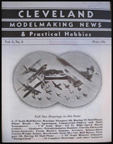



The Cleveland Modelmaking News
Click to Enlarge
As far as I know, these are the only six issues published. However, they are also as rare as hen's teeth and for something this obscure, who konows --- there could be more. Grab them if you see them!
The critical element of the Cleveland Model was the blueprint -- this had enough information to completely build the plane. The parts that were printed on balsa wood sheets were a convenience, not a necessity. Thus, once you have the plans, you can build the plane -- just add balsa and hours of patient work. This is of great benefit to those of you who might want to try your hand at matching wits with the 14 year olds of the 1930s and 1940s.
You can buy reproductions of the plans directly from the Cleveland Company. These are first rate copies, printed from the original plates. They average about $20 per set, more for bigger planes. All the famous Cleveland designs are available, and the folks who answer the phones are very, very friendly English-speaking American people who are really in Cleveland.
Often, unbuilt Cleveland kits appear in the internet auctions. If you want to bid on one of these, make sure that the plans are included.. Recently, prices have been astronomically high. If you really like building models, you'd be better off buying the plans than owning a precious original box. Those are for "investors", not modelers. If you buy an original kit, copy the plans and save the thing as an "investment".
Aside: if you really want to match wits with the 14 year olds of the 1930s, check out our Fisher Body Guild Page.
SPAD S.VIII Fighter


SPAD S.VIII Fighter
left: Eddie Rickenbacker with his SPAD, 1917
right: Eddie Rickenbacker's SPAD, restored
Click to Enlarge
The SPAD S.VIII was a French biplane fighter aircraft of World War I, developed by Société Pour L'Aviation et ses Dérivés (SPAD) . It was one of the most capable fighters of the war, and 8,472 were built. The S.VIII incorporated a number of aerodynamic and other refinements, including larger wings and rudder, a more powerful engine, a large "right-hand" propeller, and two 30-caliber Vickers machine guns.
It was faster than its main contemporaries, the British Sopwith Camel and the German Fokker D.VII, and was renowned for its ruggedness and strength in a dive. The downside was that the SPAD S.VIII was hard to manever at low speed, especially in landing. It was the bane of novice pilots.
Here is a video of a restored SPAD S.VIII in flight:
This was a popular Cleveland kit and the construction of the model is almost the same as the manufacture of the full-sized plane.
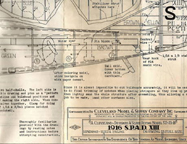


Cleveland Model of the SPAD S.VIII
Click to Enlarge
You can buy the plans and patterns that will enable you to make this model right now. Click Here to go to the exact location on the Cleveland Website to get them.

the SPAD S.VIII at the Cleveland Site
Click to Enlarge
Douglas O-38 Observation
During World War I, observation aircraft provided ground commanders with vital reconnaissance information, and throughout the interwar years, commanders of U.S. Army ground forces demanded adequate observation support. However, most ground commanders anticipated fighting a static or slow-moving war, and the observation aircraft purchased during the 1920s and early 1930s differed little from those flown over France in 1918.


Photos of the Douglas O-38
Click to Enlarge
The important family of Douglas observation aircraft sprang from two XO-2 prototypes, the first of which was powered by the 420 hp Liberty V-1650-1 V-engine and test-flown in the autumn of 1924. The second XO-2 was powered by the 510 hp Packard engine, which proved unreliable. The US Army ordered 45 O-2 production aircraft in 1925, these retaining the XO-2's welded steel tube fuselage, wooden wings and overall fabric covering but at the same time introducing aluminium panels on the forward fuselage.
The Douglas O-38F was the last of the series of observation aircraft that evolved from the prototypes. Between 1931-1934, Douglas built 156 O-38s for the Air Corps. It was one of the Army Air Corps' best known and most versatile airplanes during the 1930s. However, with a cruising speed of only 128 mph, it was obsolete by the end of the 1930s. Even so, some O-38s remained in service at the time of Pearl Harbor in 1941.
Click Here for more information about the Douglas O-38.
Here is the Cleveland model of the Douglas O-38.

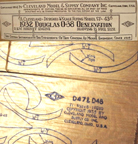

Cleveland Model of the Douglas O-38
Click to Enlarge
You can buy the plans and patterns that will enable you to make this model right now. Click Here to go to the exact location on the Cleveland Website to get them.

Douglas O-38 at the Cleveland Site
Click to Enlarge
Curtiss F-8C "Falcon" (or "Helldiver") Fighter
The Curtiss Falcon was a military biplane aircraft built by the United States aircraft manufacturer Curtiss Aeroplane and Motor Company during the 1920s.
Most saw service as part of the United States Army Air Corps as observation aircraft with the designations O-1 and O-11, or as the attack aircraft designated the A-3 Falcon.
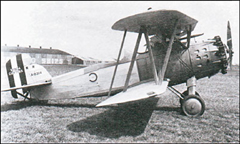
Curtiss F-8C "Falcon" (or "Helldiver")
Click to Enlarge
U.S. Navy variants were used initially as fighter-bombers with the designation F8C Falcon, then as the first U.S. Marine Corps dive bombers with the name Helldiver. Two later generations of Curtiss dive-bombers would also be named Helldiver. The type was introduced in 1925 and saw first-line service in the United States until 1934. The F8C is the airplane that is used to do in poor old King Kong.
This is a roughly contemporaneous Cleveland kit for the F8-C



Cleveland Model of the Curtiss F8-C
"Falcon" or "Helldiver"
Click to Enlarge
You can buy the plans and patterns that will enable you to make this model right now. Click Here to go to the exact location on the Cleveland Website to get them.

Curtiss F-8C "Falcon" (or "Helldiver") at the Cleveland Site
Cleveland also made a kit of a very special version of the F8C, the civilian version of which only one was made for use by Assistant Secretary of Navy David Ingalls (He was the USN's only WW1 ace, and a fascinating guy - you should read about him.). It was originally designated A-4, and later redesignated XF8C-7. Yes, the note on the cleveland plans is wrong. It reportedly cost $19,934, a vast sum during the Depression.


Cleveland Model of the Curtiss XF8C-7 "Command Helldiver"
left: the Real Thing
Click to Enlarge
This kit also illustrates clearly that the copyright date on the plans is NOT the actual date of the kit. The plans are properlly copyrighted in 1934, but the box indicates that the kit is from the 1950s.
You can buy the plans and patterns that will enable you to make this model right now. Click Here to go to the exact location on the Cleveland Website to get them.

Curtiss XF8C-7 "Command Helldiver" at the Cleveland Site
Click to Enlarge
Lincln Sport Light Civilian Biplane
The Lincoln Aircraft Co. of Lincoln, Nebraska was a well-known aircraft manufacturer of the 1920s and 1930s. The company was owned by Victor Roos who was one of the few aviation pioneers whose name did not become a household word. 1n 1927, Roos was the partner of Clyde Cessna, founding what has become the Cessna Company today. For a time, Roos was also associated with Mario Bellanca, one of the foremost aircraft designers of the 1930s. Lincoln aircraft manufactured the "Sport" a small biplane that was also sold as kit for homebuilders. In 1931, Lincoln Aircraft merged with the American Eagle Aircraft Corp. of Kansas City, Kansas. The "Sport" was popular and is in great demand today by aircraft collectors. The plans are still sold, and, as shown below, construction of a full-scale version is almost identical with building the Cleveland model.





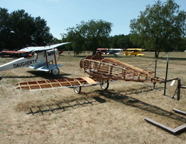
The Lincoln Sport Biplane
Click to Enlarge
As yu can see, the Cleveland kit and the real Sport are constructed in much the same manner. At one time, building a Cleveland kit was good training for the aircraft industry.


Cleveland Model of the Lincoln Sport
Click to Enlarge
You can buy the plans and patterns that will enable you to make this model right now. Click Here to go to the exact location on the Cleveland Website to get them.

Lincoln Sport at the Cleveland Site
Great Lakes 2T1-A "Sport Trainer" Racing Trainer
In 1929, the Great Lakes Aircraft Company (GLAC) was formed in Cleveland, Ohio They built civilian biplanes, float planes, as well as biplane torpedo bombers but is best known for the enduring 2T biplane; also known as the Great Lakes Sport Trainer. It was designed and sold as a two-place, open cockpit biplane.
The original models had a wing span of 26 feet 8 inches and length of 20 feet 4 inches and the range was 375 miles. The sale price started out at $4,990 but as the depression came it was lowered to $3,985. The first four Sport Trainers built were of a rare straight-wing design, one of which was modified into a special racer. Because of problems recovering from flat spins, the top wing was swept back and that is what most people recognize first when looking at a Sport Trainer.


Great Lakes 2T-1A Sportster
Patent for tubing bending device, No. 1,886,082
Click to Enlarge
For about 30 years, until the late 1960s, the Great Lakes Sport Trainer was the top American-made acrobatics plane. During the 1960s Harvey Swack of Cleveland, Ohio, obtained the rights to the Sport Trainer design and all the factory drawings and patents for it (such as the tubing bending device shown above) and then sold plans to homebuilders. There have been a great number homebuilt Great Lakes Sport Trainers built over the years, which kept interest in this old biplane alive. In 1973 Doug Champlin brought the Great Lakes back into production. With the exception of using modern materials, the general design was not changed. Here is the Cleveland Kit for this plane:

Cleveland Model of the Great Lakes 2T-1A Sportster
Click to Enlarge
You can buy the plans and patterns that will enable you to make this model right now. Click Here to go to the exact location on the Cleveland Website to get them.

Great Lakes 2T1-A "Sport Trainer" at the Cleveland Site
Caudron C-460 "Rafale" Racer
The Caudron C.450 and C.460 Rafale ("Squall") were French racing aircraft built to participate in the Coupe Deutsch de la Meurthe race of 1934. The race was founded by French aviation pioneer Ernest Archdeacon and funded by Henri Deutsch de la Meurthe, the legendary "Oil King of Europe."
This race is quite significant in that it has historical roots in advancing aviation technology. Each year, the race rules were changed to stimulate development of new capabilities. For 1934, the rules stressed three points: (1) engines were to 8 litres (488.2 cu. in.) capacity; (2) The race covered 1,242 mile; and (3) the aircraft had to take-off and land in a small space after clearing an obstruction. This was a veiled description of a long-range fighter-interceptor that could operate within range of most European capitals, particularly Berlin.

Mlle. Deutsch de la Meurthe with the five Caudron pilots


Ernest Archdeacon and Henri Deutsch de la Meurthe
Click Here to download a ".pdf" with details of the 1934 race
Click to Enlarge
The Caudron entries were low-wing cantilever monoplanes of conventional configuration. In the event, the C.450 took first place, piloted by Maurice Arnoux, and one of the C.460s took third, piloted by Albert Monville.



Photos of the Caudron C. 460 "Rafale"
Click to Enlarge
In the same year, Avoins Caudron brought the C.460 to the United States for the National Air Races. Described as "sleek as a barracuda and blazingly fast" began race week by beating America’s best aircraft for the Greve trophy race for inline engine racers (with a speed of 247.3 mph). Then, in the finale, the C.460 also won the free-for-all race for the Thompson Trophy. Michel Detroyat beat all comers with an average speed of 268 mph over the closed-course race. It would be the only time a Non-American pilot and aircraft would win the top event at the event.
Here are two videos of a modern reproduction of the the Caudron C. 460 "Rafale":
Walkaround
TV Documentary
Click Here for more information about the Caudron C. 460 "Rafale".
The C.460 was an instant hit and Cleveland rushed to offer a kit for the airplane. This design has proven to be very popular with folks who build gasoline powered models. It flies very well and is ultra-fast just like its real-life counterpart.


Cleveland Model of the Caudron C. 460 "Rafale"
Click to Enlarge
You can buy the plans and patterns that will enable you to make this model right now. Click Here to go to the exact location on the Cleveland Website to get them.

Caudron C. 460 "Rafale" at the Cleveland Site
Click to Enlarge
Rearwin 6000-C "Speedster" Light Civilian Plane
The Rearwin Speedster was a sport aircraft produced in the United States in the 1930s. It was a high-wing strut-braced monoplane of conventional design with an enclosed cabin and fixed, tailskid undercarriage. Developed during the Great Depression, work was suspended between 1934 and 1937. By the time it was resumed, the ACE Cirrus engine that had powered the two prototypes was out of production, and 14 Speedsters produced in series had Menasco C-4 engines.

Rearwin 6000-C Speedster
top: Cirrus-powered version
bottom: Menasco-powered version
Click to Enlarge
Click Here for more information about the Rearwin 6000-C "Speedster".
The Rearwin 6000-C Speedster has always been a popular subject for modeling as the large cabin has plenty of room for radio-control equipment. Cleveland only offered a kit for the Cirrus powered airplane, which meant that the gas engine had to be mounted upside down. This design has proven to be very popular and one author feels that it may have been "over-modeled." . It flies very well and will continue to be a popular subject.

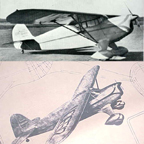
Cleveland Model of the Rearwin 6000-C Speedster
Click to Enlarge
You can buy the plans and patterns that will enable you to make this model right now. Click Here to go to the exact location on the Cleveland Website to get them.

Rearwin 6000-C Speedster at the Cleveland Site
Click to Enlarge
Turner-Laird Meteor "Pesco Special" Racer
Roscoe Turner, a colonel in the Nevada National Guard, was a famous name in race history since 1924. He was known as "Col. Turner" and appeared in robin's egg blue uniform, whipcord breeches, military cap, and gold wings with RT in bold letters. He also had traveled with a pet lion named Gilmore who got his name from Gilmore Red Lion Oil ("Roar with Gilmore"), one of his many sponsors. He won the 1932 Thompson Trophy at the National Air Races with the Weddell-Williams Racer.
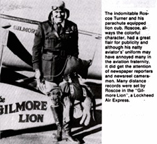

Laird-Turner Meteor ("PESCO Special")
Click to Enlarge
In 1936 Turner contracted with Lawrence W. Brown Aircraft Company to build a racing aircraft of his own design. Detailed engineering work was done by Howard Barlow of the University of Minnesota and the ship was built at the Brown factory in California and completed in mid-year 1936. It was a full cantilever mid-wing monoplane, fixed gear and powered by a Twin Wasp 1000 hp engine. The wing span racer was approximately 25 ft. and quite narrow in chord. The fuselage was constructed of chrome-moly tubing with spruce and fabric fairing. The stabilizers were constructed of wood and the elevators and rudder were steel tubing. All were fabric covered. The paint job was a silver gray, license number R263Y and race number 29. It carried 215 gallons of fuel and had an oil capacity of 15 gallons.
In 1937, the speedster was sponsored by Ring Free Oil and arrived at the Nationals wearing the name "Ring Free Meteor", a star, and race number 29 on its flanks. The name Laird in a diamond appeared on the vertical stabilizer. Due to a variety of mishaps, Turner did not win the Thompson in 1937.
Turner came back to the 1938 National Air Races with his silver Meteor and a determination to win the Thompson Trophy. During the early part of the year he had experienced problems in cooling and lubrication but these bugs had been worked out. The racer's new sponsor was the Pump Engineering Service Corporation of Cleveland. The name "Ring Free" had been removed and "Pesco Special" replaced it. In an eventful race, Turner won the Thompson with a speed of 283.416 mph, turning one lap at 293 mph. With this win he became the only two time winner of the Thompson Trophy Race.
Turner came back back in 1939. No changes had been made in the ship, except Champion Spark Plugs now sponsored and the plane was named "Miss Champion". He went on to win with a speed of 282.5 mph and became the first and only three time winner of the Thompson Trophy Race. After the race Colonel Turner stated that he and the "Miss Champion" were retiring from the race game. Today the racer can be seen hanging in the Roscoe Turner hangar at Indianapolis.
Here is a video of large scale model the Laird-Turner Meteor ("PESCO Special"):
Click Here for more information about the Laird-Turner Meteor ("PESCO Special").
This was a popular airplane and Cleveland rushed to get it out in 1938. You will note that the plans say "PESCO Special" the plane's name in 1938. However, the kit is apparently from 1939 or later because it also includes a "Champion Spark Plugs" label -- just in case the modeler wanted to be courant. We also note that the kit has the blueprints for a pylon-shaped display stand for the model. Like most Cleveland kits, however, it was made to fly -- from the box it looks like you could put a very large ("D" Class) gas engine in the model.



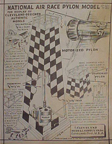
Cleveland Model of the Laird-Turner Meteor ("PESCO Special")
Click to Enlarge
You can buy the plans and patterns that will enable you to make this model right now. Click Here to go to the exact location on the Cleveland Website to get them.

Laird-Turner Meteor ("PESCO Special") at the Cleveland Site
Click to Enlarge
Lockheed L-10 "Electra" Transport
The Lockheed L-10 Electra was a twin-engine, all-metal monoplane airliner developed by the Lockheed Aircraft Corporation in the 1930s to compete with the Boeing 247 and Douglas DC-2.


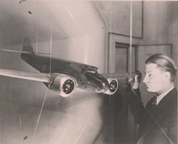
Lockheed L-10 "Electra"
(left) Amelia Earhart and her L-10 Electra
(right) "Kelly" Johnson and the wind tunnel test model of the Electra
Click to Enlarge



Hall Hibbard's Design for the Lockheed Electra
Design Patent D-92,654
Click to Enlarge
In May 1937, H.T. "Dick" Merrill and J.S. Lambie accomplished a round-trip crossing of the Atlantic Ocean. The feat was declared the first round-trip commercial crossing of that ocean, and it won them the Harmon Trophy.[citation needed] On the eastbound trip, they carried newsreels of the crash of the Hindenburg, and on the return trip, they brought photographs of the coronation of King George VI. In July 1937, aviatrix Amelia Earhart disappeared in a highly-modified Electra during an attempted round-the-world flight.
Many Electras were pressed into military service during World War II, designated C-36. Several are still airworthy.
Here is a video of the Lockheed L-10 "Electra" used in the 2009 film Amelia:
Click Here for more information about the Lockheed Electra.
Cleveland made a kit for the Electra almost concurrent with its first flight in 1934. In those days, manufacturers were eager to build enthusiasm for new commercial planes in the modeling community. In those days, there wasn't a whole lot of difference between the model and the real thing and modelers tended to be way above average in the knowledge of and influence in aviation. In an early instance of "Product Placement" we note that the Cleveland kit offers the builder insignia for Eastern Airlines to place on the completed model.



Cleveland Model of the Lockheed L-10 "Electra"
Click to Enlarge
You can buy the plans and patterns that will enable you to make this model right now. Click Here to go to the exact location on the Cleveland Website to get them.
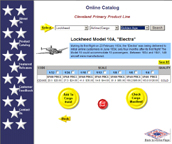
Lockheed L-10 "Electra" at the Cleveland Site
Click to Enlarge
Lockheed "Hudson" Bomber
The Lockheed Hudson was an American-built light bomber and coastal reconnaissance aircraft built initially for the Royal Air Force shortly before the outbreak of the Second World War and primarily operated by the RAF thereafter. The Hudson was the first significant aircraft construction contract for the Lockheed Aircraft Corporation—the initial RAF order for 200 Hudsons far surpassed any previous order the company had received.



Lockheed Hudson
Click to Enlarge
In 1938, Lockheed sold modified version of the Lockheed Electra airliner to the British Purchasing Commission as a bomber. They were swiftly delivered to England. By the start of the war in 1939, 78 Hudsons were in service. A total of 370 Hudsons were supplied. These had two fixed Browning machine guns in the nose and two more in a dorsal turret. In a later version one ventral and two waist machine guns were added (428 produced); engine horsepower was increased from 1,000 hp to 1,200 hp to carry the increased weight.
Although later outclassed by larger bombers, the Hudson achieved some significant feats during the first half of the war. In October 1939, a Hudson became the first RAF aircraft to shoot down a German aircraft. (The first British aircraft to shoot down a German plane was a Navy Blackburn Skua) Hudsons operated as fighters during the Battle of Dunkirk. A Hudson of US Navy squadron VP-82 became the first US aircraft to destroy a German submarine when it sank U-656 southwest of Newfoundland in March 1942. Following Japanese attacks on Malaya, Hudsons became the first aircraft to make an attack in the Pacific War, sinking a Japanese transport ship, an hour before the attack on Pearl Harbor. During the war, they were used as maritime patrol aircraft in the Pacific by the US Navy, the RAAF and the Royal New Zealand Air Force. A total of 2,584 Hudsons were built. They began to be withdrawn from front line service in 1944.
Here is a video about the Lockheed Hudson:
Click Here for more information about the Lockheed Hudson.
Here is a Cleveland kit for the Hudson. This is probably from the immediate Post-WWII period because it does not have notation that "balsa is a strategic material."

Cleveland Model of the Lockheed Hudson
Click to Enlarge
You can buy the plans and patterns that will enable you to make this model right now. Click Here to go to the exact location on the Cleveland Website to get them.

Lockheed Hudson at the Cleveland Site
Click to Enlarge
Douglas DC-2 Transport


(Left) Douglas DC-2 Transport
(Right) The DC-3, its famous cousin
Click to Enlarge
In the early 1930s, fears about the safety of wooden aircraft structures led many airlines and manufacturers to experiment with all-metal aircraft. The Boeing 247 (also discussed on our site) was one of the firt of these. At the time, United Airlines was part of the Boeing conglomerate. Howard Hughes' Transcontinental and Western Airways (TWA)looked to the Douglas Corporation for an effective competitor.
In 1933, the prototype DC-1 was rolled out featuring a distinctive tapered wing, retractable undercarriage, and two engines. It seated 12 passengers. TWA accepted the basic design and ordered 20, with more powerful engines and seating for 14 passengers. This version was known as the "DC-2" and further orders followed including European airlines such as KLM, LOT, Swissair, CLS and LAPE. A total of 156 DC-2s were built. Improvements in passenger capacity, speed and range were mad to the basic airframe, resulting in the famous DC-3 that had production in the thousands. In 2009, several airlines were still using DC-3s in regular passenger service.
This marvelous airplane was designed by Arthur Raymond. Here are some representative patents that show the external configuration, the wing section and the innovative retracting landing gear.




Arthur Raymond Patents for the DC-2
Exterior, Design Patent D-94,427
Wing and Landing Gear Patent No. 2,049,066
Click to Enlarge
Here is a very nice video of a restored DC-2
Cleveland produced detailed models of BOTH the DC-2 and the DC-3. The large scale models are exceptionally detailed. A partial model of the DC-3 cockpit -- in amazing detail -- is on display at the National Air and Space Museum. This should be an inspiration to balsa modelers everywhere and is definitely worth a trip just to see it



Cleveland Model of the Douglas DC-2 Transport
Click to Enlarge
You can buy the plans and patterns that will enable you to make this model right now. Click Here to go to the exact location on the Cleveland Website to get them.
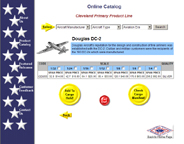
The Douglas DC-2 on the Cleveland Site
Fairey Battle Bomber
The Fairey Battle was a British single-engine light bomber built by the Fairey Aviation Company in the late 1930s for the Royal Air Force. The Battle was powered by the same Rolls-Royce Merlin piston engine that gave contemporary British fighters high performance; however, the Battle was weighed down with a three-man crew and a bomb load. Despite being a great improvement on the aircraft that preceded it, by the time it saw action it was slow, limited in range and highly vulnerable to attack.


Photos of the Fairey "Battle"
Defense and Offense were almost nonexistent!
Click to Enlarge
The original Fairey Battle was designed as a two-seat day bomber. The Battle was an all-metal, low-wing cantilever monoplane, equipped with a retractable tail wheel landing gear. Its clean design, with a long and slim fuselage and cockpit for three (pilot, navigator and gunner) seated in tandem with a continuous glazed canopy, was similar to a large fighter, rather than a bomber. It had neither an armored cockpit nor a self-sealing fuel tank. The Battle's defence consisted of a single .303 machine gun mounted in the rear cockpit and a single forward-firing machine gun in the starboard wing. The Battle's standard payload of four 250 lb bombs was carried in cells inside the wings and an additional 500 lb of bombs could be carried on underwing racks.
The Battle was obsolete by the start of the Second World War, but remained a front line RAF bomber due to a lack of a suitable replacement. On 20 September 1939, a German Messerschmitt Bf 109 was shot down by a Battle gunner, marking the RAF's first aerial victory of the war. Nonetheless, the Battle was hopelessly outclassed by Luftwaffe fighters, being almost 100 mph slower than the contemporary Bf 109 . When the Battle of France began, Battles were called upon to perform unescorted, low-level tactical attacks against the advancing German army. In the first of two sorties carried out by Battles, on 10 May 1940, three out of eight aircraft were lost while, in the second sortie, a further 10 out of 24 were shot down, giving a total of 13 lost in that day's attacks, with the remainder suffering damage. Despite bombing from as low as 250 ft, their attacks had little impact on the German columns. In a desperate attempt to stop German forces crossing the Meuse, the Advanced Air Striking Force launched an "all-out" attack by all available bombers against the German bridgehead and pontoon bridges at Sedan. The light bombers were attacked by swarms of opposing fighters and were devastated. Out of a strike force of 63 Battles and eight Bristol Blenheims, 40 (including 35 Battles) were lost. After these abortive raids, the Battle was switched to mainly night attacks, resulting in much lower losses. Eventually, it was removed from combat altogether.
The Battle's benign handling characteristics made it an ideal platform for testing engines, and it was used in this role to evaluate engines up to 2,000 hp. As the dual-control Fairey Battle T, it served as a trainer. As the winch-equipped Fairey Battle TT (target tug) it was used as a target-towing aircraft for training in air gunnery. The Battle served as a trainer with the Royal Australian Air Force, the Royal Canadian Air Force, and the South African Air Force. From August 1939, 739 Battles were stationed in Canada as trainers in the Commonwealth Air Training Plan. Most were used for bombing and gunnery training with a small number equipped as target tugs. Some aircraft had the rear cockpit replaced with a Bristol Type I turret for turret-gunnery training.
Click here for a short video about the restoration of a Fairey "Battle". Here is a video of a large scale radio-controlled model of the Fairey "Battle":
Click Here for more information about the Fairey "Battle".
Cleveland made a kit for the Fairey Battle, but given its notoriously poor performance in the Battle of France, it was most likely apoor seller. This would be a rarity if you should come upon it. However, the Battle was an easy plane to fly and (somewhat ironically) is ideally suited for modeling. That long greenhouse canopy allows one to install a plethora of radio control ewuipment.


Cleveland Model of the Fairey "Battle"
Click to Enlarge
You can buy the plans and patterns that will enable you to make this model right now. Click Here to go to the exact location on the Cleveland Website to get them.

Fairey "Battle" at the Cleveland Site
Click to Enlarge
Boeing Model 247 Airliner

The Boeing Model 247
Click to Enlarge
The Boeing Model 247 was the logical extension of the Model 215 (above) bomber which, in turn grew out of the single engine Monomail, the common denominator being the cantilever monoplane wing. Development focused on the fuselage to provide accomodation for accommodation for a pilot, copilot, stewardess and 10 passengers. Looking backward, the Boeing 247 was the prototype for the modern airliner
The Model 247 had impressive technical features as well. It could climb and maintain altitude with a full load with one engine inoperative. It was also equipped with pneumatic de-icing boots to prevent ice accretion at high altitude.


Patent Diagrams for the Boeing Model 247
Design Patent D-87,440
Click to Enlarge
Click Here to learn how to get free patent diagrams
The airplane was used by United Airlines. Here is a link to a video that shows the Model 247 in action. In this film, "United" masquerades as "General Airlines". The airplane entered World War II as the C-73 transport.
Cleveland offered a kit for the 247, but two engine aircraft were generally beyond the capabilities of children. It is reported that the Cleveland 247 is a good subject for free-flight and radio control modeling.


Cleveland Model of the Boeing Model 247
Click to Enlarge
You can buy the plans and patterns that will enable you to make this model right now. Click Here to go to the exact location on the Cleveland Website to get them.

Boeing Boeing Model 247 at the Cleveland Site
Cleveland and Pilot Training
During the 1920s through 1945 you could get credit toward pilot training by building Cleveland models. They were actually used in early military training because the construction techniques for the model were virtually the same as for the full-sized airplanes.



Cleveland Kits were quite relevant to military training
Click to Enlarge
Above is an ad from about 1943. These are the 36" wingspan models (except for the bomber) Multiply the 1943 prices by about 25 to get the 2009 equivalent price. Most of the planes in the ad would have been in the War news, so again the Cleveland Company was offering "state of the art" subjects to modelers. Cleveland continued to make kits even after the plane had moved from "cutting edge" to museum piece. The fact that Cleveland was involved with a subject from the beginning gave great authenticity to the plans. Here is a 1959 kit for the same P-40 that was advertised above in 1943.

1959 Cleveland Kit for the P-40 Warhawk
Click to Enlarge
Note that the graphics on the box had changed by the 1950s. This is a useful clue to determining the date of any particular Cleveland Kit.
Sinson Reliant
This was a popular single-engine four to five seat high-wing monoplane manufactured by the Stinson Aircraft Division of the Aviation Manufacturing Corporation of Wayne, Michigan. The Reliant is a three-place high-wing land monoplane powered with a Lycoming Model R-680-13 Engine. The engine is fitted with an 8'6" constant speed propeller and the conventional landing gear is equipped with hydraulically-operated brakes. 1,327 were made from 1933 to 1941, in different models, from SR-1 to SR-10. The last model was introduced in 1938. The SR-10 Reliant was available as a landplane, seaplane and skidplane. The SR-10 was used by the U.S. Army in World War II as a utility aircraft, designated UC-81, and as trainer designated AT-19. They were also used by the Royal Navy and Royal Air Force for light transport and communication duties. After the war they were sold on the civilian market as the Vultee V-77. For more information about this fascinating aairplane, check out the Stinson Reliant Webpage at the National Air and Space Museum. Here is a video of a restored Reliant:

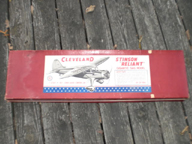
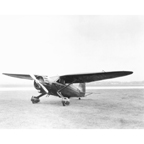
The Sinson Reliant, Military and Civilian Versions
The Cleveland 1/6 Kit Suitable for Radio Control
Click to Enlarge
This particular kit is of some note because in 1937, Cleveland Model & Supply Company entered gas-powered model aviation with the introduction of a 1/6th-scale kit of the Stinson SR-7, "Reliant." The 81-inch span "Reliant" was priced at $8.50 ($270 in today's dollars).
This is also a good example of the very large kits (2"=1 foot) that Cleveland made for radio control enthusiasts. This thing had an 81 inch wingspan (that's 6 1/2 feet or so!). The model had plenty of room inside for all the bulky tube-type radio gadgetry of that time. For this model, the Cleveland folks gave you those hardwood wheels, but they wouldn't do much for a real landing. Of interest, you also got pre-formed streamlined wheel covers for the fixed landing gear. (They are known as spats in the trade.)
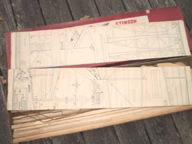
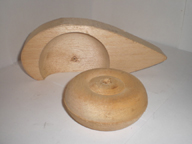

Inside the Cleveland Kit
Click to Enlarge
This type of kit would appeal mainly to those with a fairly large workspace. In general, these planes were made with detachable wings that would make it possible to transport the behemoth in a car. Old time radio control was a thing to behold.

Stnson Reliant at the Cleveland Site
You can buy the plans and patterns that will enable you to make this model right now. Click Here to go to the exact location on the Cleveland Website to get them.
Beechcraft Bonanza
The Beechcraft Bonanza is an American general aviation aircraft introduced in 1947 by The Beech Aircraft Corporation of Wichita, Kansas. As of 2009, it is still being produced by Hawker Beechcraft and has been in continuous production longer than any other airplane in history. More than 17,000 Bonanzas of all variants have been built. Designed by a team led by Ralph Harmon, the model 35 Bonanza was the first truly modern high-performance personal aircraft. It was a very fast, low-wing monoplane at a time when most light aircraft were still made of wood and fabric. The Model 35 featured retractable landing gear and its signature V-tail (equipped with a combination elevator-rudder called a ruddervator), which made it both efficient and the most distinctive private aircraft in the sky. The prototype 35 Bonanza made its first flight on 22 December 1945, with the first production aircraft debuting as 1947 models. The first 30-40 Bonanzas produced had fabric-covered flaps and ailerons, after which those surfaces were covered with magnesium alloy sheet
Here is a contemporary video showing four "Bonanzas" flying in formation.


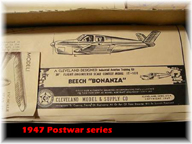
This 1947 Cleveland Model was definitely "au courant"



Be careful when you cut...
Click to Enlarge
The Cleveland Company drew fantastic plans but economized on the balsa -- this photo shows some of the Formers printed on the sheet where the grain of the wood made them ultra-hard to cut out ANF prone to splitting. My trick is to coat the balsa with clear dope on both sides. Then cut to about 1/16" of the line and sand the rest of the way with an emery board. I get the best fit if just the faintest trace of the line is showing on the cut-out part. All symmetric (or identical, like wing ribs) should be stacked on top of each other for a final sanding to assure that they match perfectly. I made a special gadget to cut the notches for the stringers so that they would exactly accept a 1/16" or 1/8 balsa strip.

Beechcraft Bonanza at the Cleveland Site
Click to Enlarge
You can buy the plans and patterns that will enable you to make this model right now. Click Here to go to the exact location on the Cleveland Website to get them.
Cessna Model 120 Private Plane

Cessna Model 120 Private Plane
Downmarket version of the Model 140..
Click to Enlarge
The Cessna 120 and the Cessna 140 are single engine, two-seat, light general aviation aircraft that were first produced in 1946, immediately following the end of World War II. Production ended in 1950, and was succeeded by the Cessna 150, a similar two-seat trainer which introduced a tricycle gear.
The Cessna 140 was originally equipped with an 85 horsepower (63 or Continental horizontally-opposed, aircooled, four-cylinder piston engine. This model has a metal fuselage and fabric wings with metal control surfaces.
The Cessna 120 was an economy version of the 140 produced at the same time. It had the same engine as the 140, but did not have wing flaps. The cabin "D" side windows and electrical system (radios, lights, battery and starter) were optional
The larger Cessna 170 was a four seat version of the 140 with a more powerful engine.
7,664 copies of the 120 and the 140 were sold in the five years that the aircraft were produced.
Here is a closeup video of a Cessna 120 that is still flying today.
The simpler Model 120 is an excellent subject for radio-control modeling and was a popular Cleveland kit

Cleveland Model of the Cessna Model 120
Click to Enlarge
You can buy the plans and patterns that will enable you to make this model right now. Click Here to go to the exact location on the Cleveland Website to get them.

Cessna Model 120 at the Cleveland Site
Click to Enlarge
Experimental "Minnow" Air Racer
The "Minnow" was a small experimental airplane designed specifically for the small engine (190 cc) class of the National Air Races, held in Cleveland, Ohio.
The races were major national event of the "Air Age" and drew the best flyers of the time, including James Doolittle, Wiley Post, Frank Hawks, Jimmie Wedell, Roscoe Turner, and other aviation pioneers.
The races included a variety of events, including cross-country races that ended in Cleveland, landing contests, glider demonstrations, airship flights, and parachute-jumping contests. The races usually ran for up to 10 days, usually at the end of August. The most popular event was the Thompson Trophy Race, a closed-course race where aviators raced their planes around pylons, the event for which the Minnow was designed.
During World War II the races were on hiatus. When competition resumed after World War II, they featured newer surplus military planes that greatly outclassed the planes from the pre war era. In 1949 Bill Odom lost control of his P-51 "Beguine" and crashed into a home, killing himself and two people inside. The races went on hiatus again.



The "Minnow"
It gets its name from the small size
Click to Enlarge
The Minnow (license number N22C) was built by a group of Lockheed employees and piloted to victory in 1848 by Herman "Fish" Salmon. "Fish" started work at Lockheed in 1940 ferrying Hudsons to Montreal for the Royal Air Force. In 1945, he was transferred to the engineering test piloting where he dive tested the P-80 Shooting Star, the XF-90 penetration fighter prototype, and the F-94C Starfire. He certification tested two of the models of the Constellation for the Civil Aeronautics Administration. He made the first flights of such aircraft as the P-3 Orion, YF-104A Starfighter, and the XFV-1 tailsitter, which was named in his honor.
After winning the 1948 race, the "Minnow" was modified and entered the 1949 race as "Miss Cosmic Wind". It failed to win any more trophies and continued to be morphing through several forms. Only fragments of the original plane survive today.
Replica versions of the Minnow abound. Here is a video of one such replica taking off from the deck of the USS MIdway a museum-aircraft carrier in San Diego harbor.
Cleveland offers kits for both the "Minnow" and the "Cosmic Wind" versions, a testament to the interest in the Air Races by the model-making public. I built the "Cosmic Wind" model in the 1950s and found it to be very challenging due to the streamlined shapes.





Cleveland Model of the Minnow Air Racer
Click to Enlarge
You can buy the plans and patterns that will enable you to make this model right now. Click Here to go to the exact location on the Cleveland Website to get them.

The Minnow at the Cleveland Site
Aeronca Sedan Private Plane
In 1928, the Aeronautical Corp of America (AERONCA) was formed from Roché-Dohse organization at Lunken Airport near Cincinnati Ohio. This was the first US factory to produce sport light aircraft.
The Aeronca Sedan is a four-seat light airplane which was produced in the United States between 1948 and 1951. As such, it is comparable to the Beechcraft Bonanza and the North American Navion> The Sedan was designed primarily for personal use, but it also found applications in utility roles including bush flying, since Aeronca certified a seaplane version.
The Sedan was the last design that Aeronca put into production and was the largest aircraft produced by the company Like those of other Aeronca designs, the Sedan’s fuselage and tail surfaces are constructed of welded metal tubing. The outer shape of the fuselage is created by a combination of wooden formers and longerons, covered with fabric. The cross-section of the metal fuselage truss is triangular, a design feature which can be traced back to the earliest Aeronca C-2 design of the late 1920s.
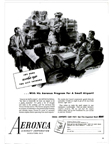


The Aeronca Sedan
Aeronca advertised extensively in mass media magazines
Click to Enlarge
The strut-braced wings of the Sedan are all-metal, in contrast to fabric-covered wings on prior Aeronca models. In general, metal wings and a fabric fuselage were not common. The contemporary Cessna 170 mated an all-metal fuselage to fabric-covered wings.
The Sedan has fixed (nonretractable) landing gear and a steerable tailwheel. The Sedan is powered by a 145 hp Continental engine . As it had with many of its other models, .
Here is a video of a restored Aeronca Sedan.

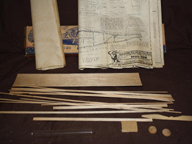
Cleveland Plans for the Aeronca Sedan
Click to Enlarge
The Aeronca Sedan is an ideal subject for radio-controlled or free-flight modeling as the high wing is not as prone to breaking in landing and takeoff "accidents".

Aeronca Sedan at the Cleveland Site
You can buy the plans and patterns that will enable you to make this model right now. Click Here to go to the exact location on the Cleveland Website to get them.
North American B-45 Tornado Bomber
The North American B-45 Tornado was the United States Air Force's first operational jet bomber, and the first jet aircraft to be refuelled in the air. The B-45 was an important part of the United States's nuclear deterrent for several years in the early 1950s, but was rapidly succeeded by the Boeing B-47 Stratojet. B-45s and RB-45s served in the United States Air Force's Strategic Air Command from 1950 until 1959.
The B-45 began development in 1944, when the War Department, alarmed by German jet bombers like the Arado Ar 234, called for a new family of jet bombers; the North American proposal (NA-130) won, and on September 8, 1944, the company began production of three prototypes based on the NA-130.


North American B-45 Tornado Bomber
Click to Enlarge
In 1946, rising tensions with the Soviet Union caused the Air Force to find a stopgap jet bomber that would serve immediate needs. The B-45 was selected early in 1947. Here is some historical documentary footage on the B-45.
It had been planned to equip five light bomb groups and three light reconnaissance groups with B-45s. However, the evolving superiority of the the B-47's did not bode well for the B-45. President Truman's budget restraints reduced Air Force expenditure and B-45 production was phased out. Only about 90 airframes were produced.



Cleveland Balsa Wood Kit for the B-45 Tornado
Click to Enlarge
As far as model making is concerned, the general notion of a tissue-covered balsa frame does not serve modern jet-powered airplanes very well. In general, the best subjects for balsa modeling are those where the actual construction mirrors the balsa construction. The particular kit shown below is from the Simplex series that Cleveland brought out in the mid-1950s. The Cleveland company thought that declining sales were due to the reluctance of Boys to cut the parts out of balsa. This series featured pre-cut parts that were assembled by the modeler. From my own perspective, balsa modeling did not seem appropriate for jet aircraft. However, as America's first jet bomber, the B-45 is certainly a worthy subject for modeling.

North American B-45 Tornado at the Cleveland Site
You can buy the plans and patterns that will enable you to make this model right now. Click Here to go to the exact location on the Cleveland Website to get them.
Boeing B-52 Stratofortress Bomber
The Boeing B-52 Stratofortress is a long-range, subsonic, jet-powered, strategic bomber operated by the United States Air Force since 1955.
In November of 1945, Air Materiel Command (AMC) issued desired performance characteristics for a new strategic bomber "capable of carrying out the strategic mission without dependence upon advanced and intermediate bases controlled by other countries". The aircraft was to have a crew of five plus turret gunners, and a six-man relief crew. It had to cruise at 300 mph at 34,000 feet with a combat radius of 5,000 statute miles. The armament was to consist of an unspecified number of 20 mm cannon and 10,000 pounds of bombs. On 13 February 1946, the Air Force issued bid invitations for these specifications, with Boeing, Consolidated Aircraft, and Glenn L. Martin Company submitting proposals. Boieing was eventually selected. Beginning with the successful contract bid on 5 June 1946, the B-52 went through several design steps; from a straight wing aircraft powered by six turboprop engines to the final prototype YB-52, with eight turbojet engines. The aircraft made its first flight on 15 April 1952 with "Tex" Johnston as pilot.


The Boeing B-52 Stratofortress
left: YB52 Prototype right: Cold War Squadron of B-52s at the ready
Click to Enlarge
Built to carry nuclear weapons for Cold War-era deterrence missions, the B-52 Stratofortress replaced the Convair B-36. Although a veteran of a number of wars, the Stratofortress has dropped only conventional munitions in actual combat. The B-52 carries up to 70,000 pounds of weapons. The USAF has had B-52s in active service since 1955, initially with the Strategic Air Command (SAC), with all aircraft later absorbed into the Air Combat Command (ACC) following SAC's disestablishment in 1992. Here is a video about the early history of the B-52.
Superior performance at high subsonic speeds and relatively low operating costs have kept the B-52 in service despite proposals to replace it with the Mach 3 XB-70 Valkyrie, supersonic B-1B Lancer and stealthy B-2 Spirit. In January 2005, the B-52 became the second aircraft, after the English Electric Canberra, to mark 50 years of continuous service with its original primary operator. There are six aircraft altogether that have made this list as of 2009; the other four being the Tupolev Tu-95, the C-130 Hercules, the KC-135 Stratotanker, and the Lockheed U-2.
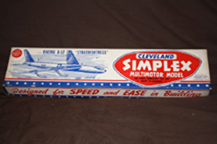

Click to Enlarge
Below is another Simplex Cleveland model of the B-52. I have never heard of a flying model of this airplane, although it is within the realm of possibilities. I invite my readers with special knowledge on this subect to Write to Me.
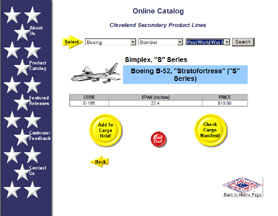
Boeing B-52 Stratofortress Bomber at the Cleveland Site
You can buy the plans and patterns that will enable you to make this model right now. Click Here to go to the exact location on the Cleveland Website to get them.
Famous aviation artist Jo Kotula provided a dramatic painting of this airplane on the "Box Art" for the Aurora kit for the Boeing B-52 Stratofortress .

Aurora Plastic Model of the Boeing B-52 Stratofortress
Artwork by Jo Kotula
Click to Enlarge
Counter for the Entire Site (not just this page..)
Home | About Lindy | 1940s Collectibles | Upcoming Events | Vintage Clothing
The Guide - Establishments - Travel - Accessories
Music | Links | Photo Gallery | Extras | Contact